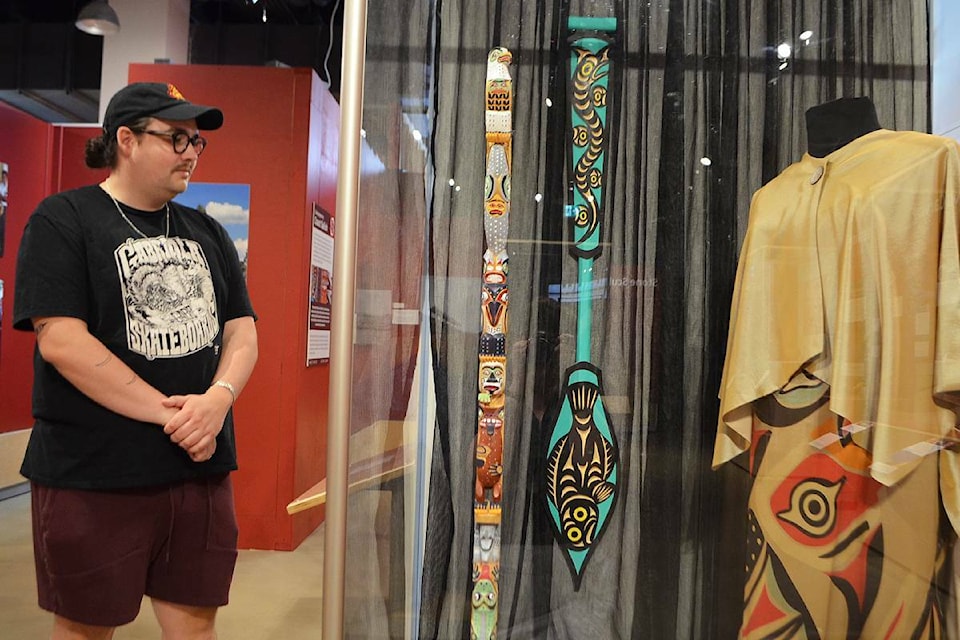The curator for a Nanaimo Museum exhibit asked himself what was sacred during a renaissance of Indigenous art.
“We’re in this moment right now where … artists are making work that is affirmative of our identities and our experiences and our stories,” said Eliot White-Hill, Kwulasultun, of Snuneymuxw First Nation. “And it comes in all different kinds of mediums and forms and it’s just really beautiful that we’re all doing this work that addresses the realities of being Indigenous today in Canada.”
The museum’s exhibit, titled ‘stem ‘al’u ‘u’ ni xe’xe: What is Sacred?’ showcases not only contemporary artworks of 12 mid-Island Coast Salish artists, but also historical and ancestral artifacts that reflect cultural teachings. As the curator of such a localized show, White-Hill acknowledged that the Salish world’s expanse far surpassed the boundaries of the exhibiting artists.
The inception of ‘What is Sacred?’ started in the spring with White-Hill’s master of fine arts thesis exhibit for the Emily Carr University of Art and Design.
Also a Coast Salish visual artist and storyteller himself, White-Hill considers the two exhibits to be parallel, in that they both address the revitalization of Coast Salish art, but do so with different voices.
The museum exhibit, he said, is a platform to celebrate and hold up the voices of Indigenous artists other than himself, and also honour the artifacts on display.
“When I first started learning about Salish art … I realized how many barriers and how many gates are in the way of us, as Coast Salish peoples, accessing knowledge about ourselves. And that almost always is told and expressed from the perspective of people who are non-Indigenous and not from our communities,” White-Hill said. “There’s been such a history of disrespect and erasure of Coast Salish art within our territories.”
An aspect of the exhibit the curator also said he was excited about was to explore the definition of Indigenous art, of what it could be, and to break free from the expectation of what other people may think it should be.
“One thing that I really found across our teachings from the elders and the ancestors is that tradition is meant to change and it’s meant to evolve. We’re a living culture,” he said, adding that traditions such as carving and weaving are beautiful and impactful, but contemporary mediums and conceptual art is as equally significant and valid.
White-Hill continued to say that when people think of Indigenous art from the Pacific Northwest, they often think of formline art, which is distinctly different from Salish design. While both use shapes to fill in a silhouetted form, the shapes and layout are comparatively different in design.
A Snuneymuxw spindle whorl taken from the community in roughly 1912 that was held in collection at the Royal B.C. Museum will be displayed during the Nanaimo show.
“It’s so significant to be able to bring it back to our community for the first time in 100 years … We worked with the museums and elders and we held a ceremony to welcome it back … We spoke and addressed them because they aren’t just objects, they’re living things. We told them that this work is happening and repatriation hasn’t happened, but it’s on the table now,” White-Hill said.
The location of the exhibit holds its own significance as well, since most of downtown Nanaimo and the city harbour was once the site of a major Snuneymuxw village called xwsaluxwul.
When considering why it’s important to make the sacred visible, White-Hill said he always goes back to teachings from his great-grandmother.
“In Salish culture, our art is so intrinsically tied to its use with ceremony and ritual … the way my great-grandma talked about it, everything is sacred, all aspects of our life and our existence and our relationships with each other and the land and every moment,” he said. “As a Salish artist, I’m always trying to think about that – what is sacred about this moment?”
‘stem ‘al’u ‘u’ ni xe’xe: What is Sacred?’ will be featured at the Nanaimo Museum until Nov. 18, and includes the work of Indigenous artists William Good, Ay Lelum, Noel Brown, Richie Brown, Steph Thomas, Gina Seward-Wilson, Ryan Hughes, Jesse Recalma, Peter Seymour, LessLIE, Dylan Thomas and Luke Marston.
READ MORE: Emerging Nanaimo artist wins YVR Foundation scholarship to pursue art
mandy.moraes@nanaimobulletin.com
Like us on Facebook and follow us on Twitter
